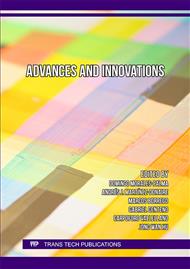[1]
M. R. Winstone, A. Partridge, and J. W. Brooks, The contribution of advanced high-temperature materials to future aero-engines, Proc I Mech Eng, 215 (2001) 63-73.
DOI: 10.1177/146442070121500201
Google Scholar
[2]
Granta Design Limited, Intelligence GM, CES EDUPACK, 2009.
Google Scholar
[3]
A. G. Evans and F. W. Zok, Review The physics and mechanics of fibre-reinforced brittle matrix composites, J. Mater. Sci., 29 (1994) 3857-3896.
DOI: 10.1007/bf00355946
Google Scholar
[4]
C. Sauder, Ceramic Matrix Composites: Nuclear applications, in: Ceramic Matrix Composites, John Wiley & Sons, Inc., Hoboken, 2014, pp.609-646.
DOI: 10.1002/9781118832998.ch22
Google Scholar
[5]
R. R. Naslain, SiC-matrix composites: Tough ceramics for thermostructural application in different fields, in: Eng. Ceram. Curr. Status Futur. Prospect, 2016, pp.142-159.
DOI: 10.1002/9781119100430.ch8
Google Scholar
[6]
K. K. Kar Editor, Processing, Applications, Characterizations, 2017.
Google Scholar
[7]
Q. Liu, G. Huang, X. Xu, C. Fang, and C. Cui, A study on the surface grinding of 2D C/SiC composites, International Journal of Advanced Manufacturing Technology, 93 (2017) 1595-1603.
DOI: 10.1007/s00170-017-0626-1
Google Scholar
[8]
O. Gavalda Diaz, D. A. Axinte, P. Butler-Smith, and D. Novovic, On understanding the microstructure of SiC/SiC Ceramic Matrix Composites (CMCs) after a material removal process, Materials Science and Engineering, 743 (2019) 1-11.
DOI: 10.1016/j.msea.2018.11.037
Google Scholar
[9]
L. Zhang, C. Ren, C. Ji, Z. Wang, and G. Chen, Effect of fiber orientations on surface grinding process of unidirectional C/SiC composites, Appl Surf Sci, 366 (2016) 424-431.
DOI: 10.1016/j.apsusc.2016.01.142
Google Scholar
[10]
G. N. Morscher, Stress-environmental effects on fiber-reinforced Sic-Based composites, in: Ceramic Matrix Composites: Materials, Modelling and Technology, Bansal and., Wiley, 2010.
DOI: 10.1002/9781118832998.ch11
Google Scholar
[11]
L. Zhang, C. Ren, C. Ji, Z. Wang, and G. Chen, Effect of fiber orientations on surface grinding process of unidirectional C/SiC composites, Appl Surf Sci, 366 (2016) 424-431.
DOI: 10.1016/j.apsusc.2016.01.142
Google Scholar
[12]
J. Du et al., New observations of the fiber orientations effect on machinability in grinding of C/SiC ceramic matrix composite,Ceram Int, 44 (2018) 13916-13928.
DOI: 10.1016/j.ceramint.2018.04.240
Google Scholar
[13]
O. Gavalda Diaz, G. Garcia Luna, Z. Liao, and D. Axinte, The new challenges of machining Ceramic Matrix Composites (CMCs): Review of surface integrity, International Journal of Machine Tools and Manufacture, 139 (2019) 24-36.
DOI: 10.1016/j.ijmachtools.2019.01.003
Google Scholar
[14]
Y. Xue et al., Damage development of a woven SiCf/SiC composite during multi-step fatigue tests at room temperature Ceram Int 46, (2020) 22116-22126.
DOI: 10.1016/j.ceramint.2020.05.270
Google Scholar



